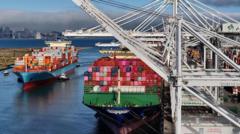U.S. President Donald Trump has implemented sweeping tariffs on more than 90 countries, enforcing new trade barriers as part of his economic strategy. Just before the deadline for international negotiations, Trump announced on Truth Social that the U.S. economy is benefiting from billions in import taxes. His administration's goal is to encourage American job creation and manufacturing, while also addressing the trade deficit - the imbalance between U.S. imports and exports.
Among the highlights, Trump has threatened India with a 50% tariff on imports to deter purchasing Russian oil and proposed a 100% tariff on foreign-made computer chips to incentivize domestic tech investment. These measures form part of Trump's broader vision to redefine the global trading system, which he believes has treated the U.S. unjustly.
The tariffs, introduced following months of market turbulence, have reached their highest average rate in nearly a century. New rates were initially announced in April but were temporarily paused as countries sought trade agreements with the U.S. Tariffs vary based on the negotiating country, with manufacturing nations like Laos and Myanmar facing the steepest rates at 40%.
Despite the turmoil, Asian markets appear to have absorbed the news with relative calm, as economists view this stabilization as a step toward assessing the overall impact of the tariffs. Major economies such as the UK, Japan, and South Korea have negotiated lower tariffs for their exports, while the European Union has agreed to a 15% tariff on goods traded with the U.S.
Trump's recent strategies prominently feature moves against major trading partners like Canada and Mexico. Following claims of inadequate collaboration to manage drug trafficking, he increased the tariff rate on Canadian goods and delayed potential tariffs on Mexico, pending ongoing negotiations. Notably, these decisions also align with geopolitical pressures, such as efforts to counter Russian influence amid the ongoing conflict in Ukraine.
Market analysts caution that Trump's aggressive tariff policies may complicate U.S. relationships with other nations, particularly another significant target like India. Concerns about the repercussions of targeting countries maintaining trade with Russia could lead to a ripple effect in international diplomacy. The tech sector is also affected, as Trump has explicitly pressured companies like Apple to increase U.S.-based production, recently spurring a major investment announcement from the tech giant.
As tariffs take effect, the global economy remains on alert, navigating through a period of unpredictability and potential strain in international trade relations.


















